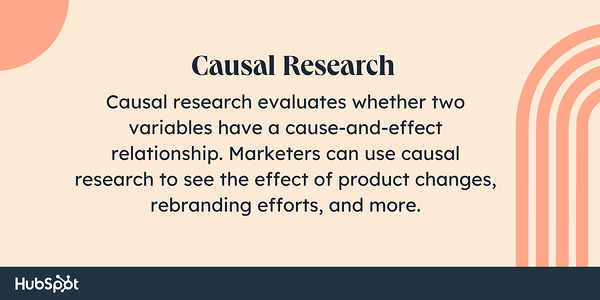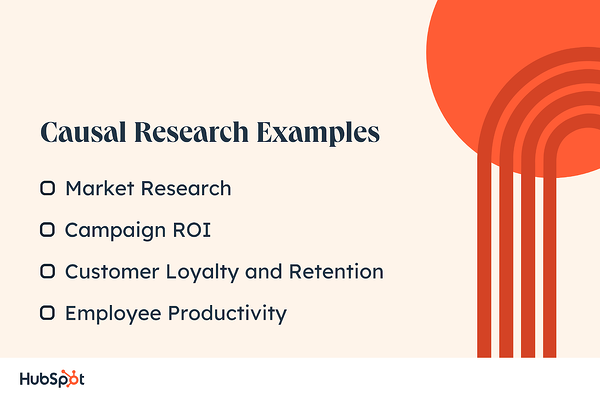As we grow up, all humans learn about cause and effect. While it’s not quite as nuanced as causal research, the concept is something our brains begin to comprehend as young as 18 months old. That understanding continues to develop throughout our lives.
In the marketing world, data collection and market research are invaluable. That’s where causal research, the study of cause and effect, comes in.
First-party data can help you learn more about the impact of your marketing campaigns, improve business metrics like customer loyalty, and conduct research on employee productivity. In this guide, we’ll review what causal research is, how it can improve your marketing efforts, and how to conduct your research.
Table of Contents
- What is causal research?
- The Benefits of Causal Research
- Causal Research Examples
- How to Conduct Causal Research
Once your team has conducted causal research, your marketers will develop theories on why the relationship developed. Here, your team can study how the variables interact and determine what strategies to apply to future business needs.
Companies can learn how rebranding a product influences sales, how expansion into new markets will affect revenue, and the impact of pricing changes on customer loyalty. Keep in mind that causality is only probable, rather than proven.

Typically, you’d use this research to differentiate between cause-and-effect relationships versus correlated relationships. Just because two variables are correlated doesn’t mean that there is a direct cause-and-effect relationship.
To conduct a study, you’d develop a hypothesis, look at your independent, dependent, control, and confounding variables, and design an experiment.
Now that we know more about what causal research is, let’s dive into the benefits of using this type of research for your business and marketing efforts.
1. You can predict hypothetical situations and improve your business strategy.
The main reason that causal research is useful is that it can help predict the outcome of business decisions, therefore improving your overall business and marketing strategy.
For example, if you’ve done causal research on product changes, you know whether or not to expect a dip in or an influx of sales. Your strategy on how to handle either situation is different, and causal research can help prepare your team for what to expect.
2. You’ll avoid ineffective and costly campaigns.
Additionally, you can avoid ineffective and costly marketing campaigns based on these predictions.
When your team is coming up with a go-to-market strategy, you’ll know the impact of pricing decisions, product enhancements, promotions that will work, etc. That insight will help you allocate your budget and put together a campaign that is effective and brings high ROI.
3. You can resolve issues, optimize strategies, and improve the overall experience.
Causal research allows your business to plan for each situation. This means that you’ll be able to resolve issues that are impacted by the variables you’re studying — whether it’s purchasing patterns, marketing results, or factors improving the customer experience.
The goal here is to always optimize your business strategies. You can improve your customer experience so customer loyalty and revenue increase.
4. You can develop an informed process.
As a business, it’s important to have a process and system for different situations whether it’s a go-to-market strategy, an ad campaign, or customer retention.
Causal research will help you develop your strategies like we’ve said, but also give you the ability to develop a process that you can iterate and use continuously. Essentially, causal research puts into action the phrase, “Work smarter, not harder.”

1. Develop a hypothesis.
The first step of conducting your own causal research is to develop a hypothesis. You need to know what you want to study before getting started.
Think about questions that you have when it comes to your team. Have you ever wondered if word length on blogs directly impacts time on page? Or maybe you want to know if your marketing campaign was the cause for an increase in sales.
Either way, the best way to get started is to write down the cause-and-effect questions you have about your team and develop a hypothesis.
2. Choose your variables.
Once you know what you want to study, you have to choose your variables. You need to know the two variables you’re testing – your dependent and independent variables.
Then, you’ll want to list out other confounding variables that may influence your study. This means identifying variables that might alter your study, including how you collect the data.
Additionally, you’ll need to have control variables set in place so you can compare your results.
3. Pick a random sampling of participants.
Now, it’s time to figure out the sample size of your experiment.
You can use technology to determine who you want your target audience to be and how random the sample should be. You can generate a random list using a database or segment your audience with your marketing software.
4. Set up a controlled experiment.
Ready, set, go. The next step is to actually conduct your experiment.
This could include sending out surveys, conducting interviews, gathering statistics and data, and more. It could also mean setting up an A/B test with your marketing software and changing only one variable in your next marketing campaign, blog post, or webinar.
5. Analyze your findings.
After you’ve conducted your experiment, it’s time to look at the results. Look at the data, and use it to see trends or patterns. Then, you’ll have the answer to your question.
However, it’s important to also analyze different correlations between your two variables to develop a nuanced interpretation. Doing this might help you develop more questions for further research, which is where the next step comes in.
6. Conduct supplemental research and report your findings.
Usually, causal research isn’t a one-and-done process. Once you have your results, you’ll have next steps to go through. You might have more questions that require further research, and if that’s the case you’ll need to conduct supplement research.
Additionally, you might just need to write down what you found. If you have a conclusive result, you can develop in-depth marketing strategies and systems.
I know all of this sounds great, but you might also be wondering how to apply this to your business and marketing team. That’s why we’ll review a few examples of causal research below.
Causal Research Examples

1. Market Research
You can use causal research at your company for market research.
For example, you might want to know how product changes impact sales. And you might want to dive deeper to see how specific types of changes will impact your target audience.
Which product variations make potential customers most interested in buying?
Pro tip: Use causal research to learn more about your target audience. What do they want from you and your product or service? Once you know there’s a cause-and-effect relationship, you’ll be able to theorize why customers make certain decisions.
2. Campaign ROI
As a marketer, you’re producing content every day. Whether it’s an ad campaign or a marketing campaign, you need to understand the results of your efforts.
With causal research, you can study whether your ad campaign directly caused an increase in sales, or whether your email marketing series led to more appointments.
Pro tip: Make sure you look at all variables so you can deduce and infer whether your campaigns were the main factor contributing to an increase in sales.
3. Customer Loyalty and Retention
Causal research can be used to identify effective customer service strategies, whether it’s a product demonstration or call time quota.
With this research, you’ll see if there’s a cause-and-effect relationship between certain customer service strategies and retaining those customers year over year.
Best for: Customer service teams.
4. Employee Productivity
Employee happiness has been a hot topic for recent years, and it makes sense. When morale is high, employee productivity is higher.
How do we know? Because there have been numerous studies done to show the cause-and-effect relationship between employee happiness and increased productivity – which in turn increases your business' bottom line.
Best for: Internal use.
Getting Started
Causal research is incredibly useful for your business – whether you’re looking at your marketing, sales, or customer service departments. In fact, one of the best ways to use it is to see how these departments interact and impact one another.
Once you’ve conducted your own causal research, you can implement more successful marketing and business strategies that increase revenue and drive sales.

![→ Download Now: Market Research Templates [Free Kit]](https://localseoresources.com/wp-content/uploads/2023/02/6ba52ce7-bb69-4b63-965b-4ea21ba905da.png)



Recent Comments